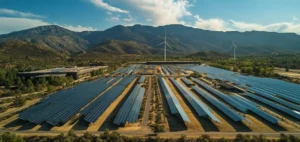The UK Department for Energy Security and Net Zero (DESNZ) grants approval for the 600 MW Cottam solar project developed by Island Green Power.
Located on former Cottam coal-fired power station infrastructure, the project is the largest of its kind in the UK to date.
Its strategic location between Lincolnshire and Nottinghamshire means that existing network connections can be reused, optimizing costs and deployment.
This approval is part of a series of recent measures by the UK government to boost its renewable energy generation capacity.
In July, three further solar farms with a combined capacity of 1.35 GW were given the go-ahead.
These developments illustrate the government’s determination to significantly increase the share of solar power in the national energy mix, through the reallocation of disused industrial land.
Energy storage and grid flexibility
Cottam’s project is not limited to solar power generation.
It also includes a 600 MW battery storage system, designed to stabilize supply and enhance the resilience of the power grid.
Energy storage is becoming an essential component in the integration of renewable energies, offering a solution to the challenges posed by the intermittency of solar and wind power sources.
This development follows a global trend where renewable energy projects increasingly include storage capabilities to maximize efficiency and profitability.
With this approach, the UK seeks to minimize the risks associated with the variability of solar generation and ensure a more stable and predictable energy supply.
Price trends and competitiveness of solar modules
The project’s approval comes against a backdrop of falling solar module costs in Europe.
According to S&P Global Commodity Insights, module prices delivered in Europe are valued at 0.12 EUR/W for volumes ranging from 5 MW to 50 MW, a significant reduction since July.
This downward trend, reinforced by falling transport costs, is encouraging the development of large-scale solar projects such as the Cottam project.
These economic conditions are creating a favorable environment for solar expansion in the UK, encouraging investment and supporting the competitiveness of domestic projects against European markets.
This situation could also prompt other developers to step up their solar energy and storage projects in the UK.
Solar energy development supported by energy policies
Government support, illustrated by the Cottam project and other recent initiatives, reflects a policy geared towards increasing solar capacity.
In the sixth round of Contracts for Difference (CfD) auctions, 3.3 GW of solar projects were awarded, including EDF Renewables’ 500 MW Longfield project.
The support framework established by these CfDs provides crucial revenue predictability for renewable energy developers.
These policies aim to make solar more competitive, notably by integrating storage elements for efficient management of the energy produced.
Projects like Cottam’s demonstrate how business and government are working together to meet energy and energy security objectives.






















